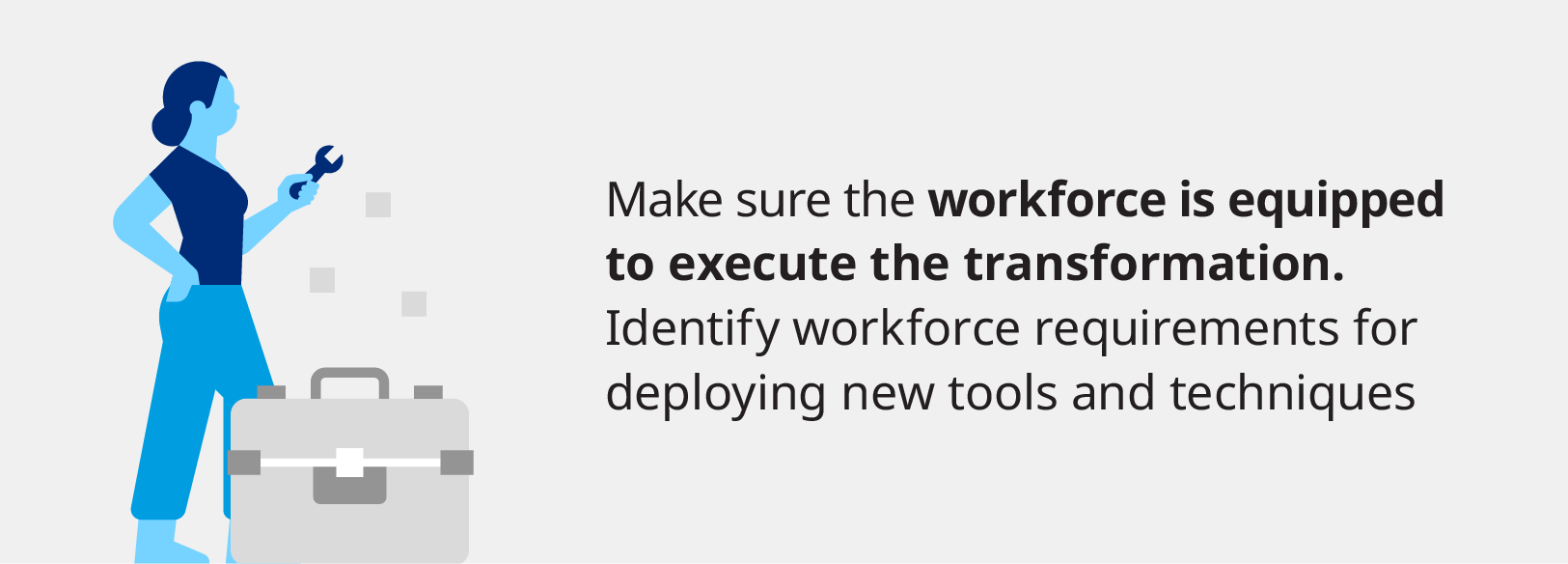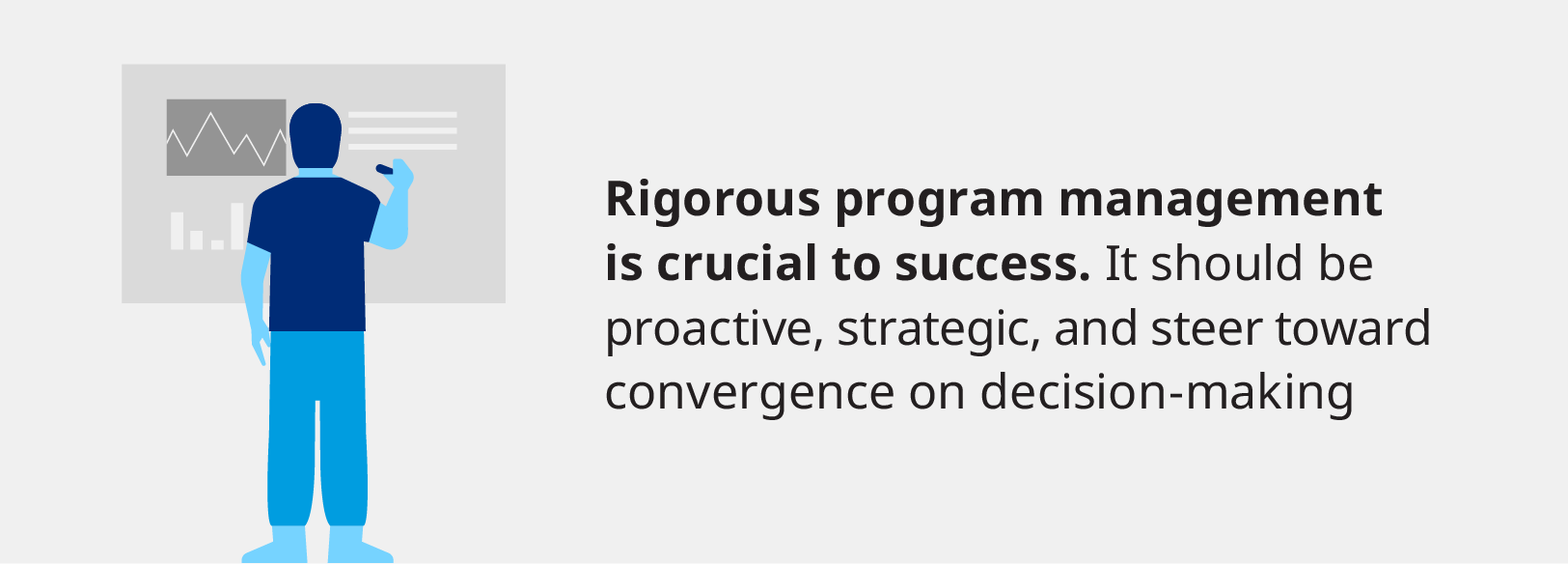Have you ever wondered what makes or breaks the success of a transformation?
Transformation programs are a critical path to growth and value, with digital transformation becoming more important as organizations overcome the challenges presented by today’s dynamic global business environment, and capture the opportunities that digitization can bring to fruition. But they’re not easy: In our recent survey of more than 240 C-suite executives across several industry-leading companies, we found that while 100% of businesses attempted a transformation in the last three years, only 25% succeeded.
Based on our analysis of hundreds of compelling and challenging digital transformation journeys with clients, we have identified key practices that executives have undertaken to decisively increase their odds of success.
Six steps to achieve successful digital transformation
1. Create a clear vision for the transformation
Much of the success of transformation programs hinges on the right leadership dynamic and alignment of a clear, inspiring vision. Our research indicates that nearly half of the companies with fully successful transformation efforts rallied the organization behind the need to change, while 56% of the companies with unsuccessful efforts reported that their transformations lacked purpose and a joint vision.
The vision from the top echoes across all levels of the organization, and must trickle down with conciseness, clarity, and practicality. Too often, we see executives falling into the trap of articulating a vision that cannot be translated into tangible and focused attributes, and that as a result ultimately does not become embedded in the organization. Communicate early and often with core teams, as well as across the organization — drive the narrative and create a safe space to engage employees, listen, and answer questions.

How to put this into practice:
- Have in-depth conversations with key stakeholders to capture the vision and emerging requirements that will inform the target state and functional capabilities.
- Focus on mission goals, business processes, advanced technology requirements, new tools to execute, and potential external events that could impact overall strategy.
- Empower local managers who will be implementing the transformation on the ground.
- Develop leaders for the future: Appoint them early, collaborate, and generate a feeling of ownership.
2. Make sure the workforce is equipped to execute the transformation
People are the drivers of digital transformations. However, few executives apply the same level of rigor to their talent and workforce that they do to deploying technical solutions. Moreover, the talent and skills necessary to advance your transformation may not be the talent and skills that currently exist in your workforce to run your business-as-usual operations.
Based on our recent study, organizations that are successful in their transformations actively identify workforce requirements based on the new tools and techniques they need to deploy, over-indexing on the skills necessary to achieve future strategic objectives. They also ensure that the workforce evolves at the same speed as the needs of the digital transformation and integrate upskilling and knowledge transfer from the very start, so that the scarcity of talent does not get in the way of continuous progress.

How to put this into practice:
- Take stock of your talent. Ask yourself: Is it adequate for the journey I am about to embark on? If the answer is “no,” then change is necessary.
- Avoid starting the organizational review too late in the transformation life cycle. Consider early on who your captains and lieutenants will be and have a vision to scale and evolve your organization over time.
3. Share accountability for the transformation program’s success
A strong ownership and accountability model is pivotal to the structure required to get results. When organizations hold both the technology executive and business owner accountable for the transformation, the odds for success increase significantly. We call this model “two in a box.”
In this model, leaders collaborate to build an aligned transformation agenda. They focus on clear objectives tied directly to measurable business outcomes. They are also accountable for feature and process changes, culture and people enablement, data availability and cleanliness, and any other need of the transformation program.
Those that effectively implement the two-in-a-box model have shared accountability and, importantly, shared financial incentives, decisively increasing the chances that the transformation will achieve its desired outcomes.

How to put this into practice:
- Align on key principles to drive convergence on technological and business operating model options. For instance, a data service that meets the technological requirements and supports the needs of the customers.
- Avoid too many chefs in the kitchen and over analysis where possible.
- Focus on the capabilities that will materially impact the decision-making process.
4. Focus on achieving small goals
Transformations are complex and often have an ambitious agenda. But organizations that establish pragmatic, bite-sized deliverables to achieve tradeoffs in the context of the larger vision are more successful. This approach demonstrates early wins, which garners buy-in for future funding and support across the organization. Since this can be quite challenging in agile transformations where milestones are not as discrete, leaders must find the balance between rapid iteration and pacing the project through measurable deliverables.
As an example, a large financial services organization that was undergoing a digital transformation undertook a hybrid agile approach — that is, implementation of agile principles where appropriate, combined with targeted milestones and deliverables. To make it work optimally, the organization established rigorous program management. More importantly though, the various workstreams came together frequently in collaborative sessions to bring to light progress and dependencies, and to activate changes that need to occur throughout the program.

How to put this into practice:
- Implement emerging technologies only when they have practical applications. Don’t go for the shiny object or a one-size-fits all approach — be pragmatic about when a technology works and when it doesn’t.
- Consider modular, microservices-based architecture, which may deliver greater near-term ROI while also enabling adoption as new platforms evolve.
- Assess the appetite for change across key constituents, and then recognize and fund an adequate change management strategy.
5. Prioritize the highest-impact initiatives
Successful organizations utilize a framework that includes materiality, severity, and frequency of their challenges, to prioritize the capabilities that need to be transformed or automated. They understand which features, processes, and functions are most correlated to the business outcomes they are trying to achieve and can establish a plan focused on those that drive the greatest value, while tracking others in a backlog for future execution. As the transformation progresses, organizations should revisit the impact assessment, reinvest to continue progress on other initiatives, and generate new ideas.

How to put this into practice:
- Avoid designing solutions for edge cases. Understand the frequency and severity of identified challenges as well as the benefits, to avoid wasting resources.
- Don’t nullify the efficiencies that come with vendor solutions by overly customizing them to bespoke business processes. Rather, be prepared to enhance or change the business processes.
- Avoid giving up ownership of the core data model and flows to a vendor. Vendor solutions that are vertically integrated — that is, those that take ownership of various parts of the technology stack — can reduce future flexibility and increase reliance on that specific vendor. A robust master data management strategy should be a leading prerequisite.
6. Rigorous program management is crucial to success
Successful program management initiatives drive clarity and transparency on progress and challenges, enabling executives to make informed decisions. In our research, we found that most firms with successful transformation efforts highlighted significantly better program management. Executives must establish a strong program discipline that includes tracking and reporting, change management, communication strategies, and escalation avenues. Program management should be proactive, with a strategic lens, and should steer toward convergence on decision-making as well as enable early visibility of interconnected themes and issues.
To illustrate, when embarking on a major transformation, a multibillion-dollar service organization instituted effective governance, tracking, and reporting processes to drive transparency across the entire organization. This effort brought forth companywide behavioral changes, and ensured that milestones were tracked, the work effort to achieve objectives was well understood, and adequate mitigating strategies were implemented as risks were identified.

How to put this into practice:
- Establish a clear implementation roadmap for seamless phasing-out of old systems and adoption of the new solution.
- Overcommunicate whenever possible — don’t assume people know.
- Maintain a log of foreseeable risks. Although these may not manifest, it keeps them on the radar to manage.
- Don’t let formality get in the way — leverage collaboration tools for rapid communication and escalation.
Despite the challenges, don’t shy away from the right thing to do
Digital transformation has become a necessity for large organizations, with, according to our survey, more than 80% of companies in the process of implementing technology changes. Before embarking on a transformation, executives should be fully aware of these six basic practices to avoid common pitfalls and achieve the desired target results.

